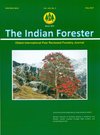Community forest Dependency: Does Distance Matter?
DOI:
https://doi.org/10.36808/if/2017/v143i5/114952Keywords:
Forest Dependency, Community Management, Sustainability, Trade, India.Abstract
With the recent economic and cultural trends, combined with the appeal of the tropical forests management and its indigenous communities livelihoods have led to the growing implementation of partnerships for sustainable forest products trade. The role of stakeholders including villagers, forest products sellers, NGOs and other associates need to be re-examined from the aspect of forest dependency. Sustainable forest products consumption or marketing by the forest dwellers may improve their livelihoods and subsequently improve the forest quality. Distance between forest and the nearest villages is an important factor for examine the level of dependency on forest harvesting. However, with the local market proximity the purpose of collection changed significantly. The present study will examine how the distance between forest, villages and local market determine the forest dependency pattern in case of Indian forestry.References
Adedayo A.G., Oyun M.B. and Kadeba O. (2010). Access of rural women to forest resources and its impact on rural household welfare in North Central Nigeria. Forest Policy and Economics, 12(6):439–450.
Adhikari B., Di Falco S. and Lovett J.C. (2004). Household characteristics and forest dependency: evidence from common property forest management in Nepal. Ecological Economics, 48(2):245–257.
Belcher B., Achdiawan R. and Dewi S. (2015). Forest-Based Livelihoods Strategies Conditioned by Market Remoteness and Forest Proximity in Jharkhand, India. World Development, 66: 269–279.
Belcher B., RuÃz-Pérez M. and Achdiawan R., (2005). Global patterns and trends in the use and management of commercial NTFPs: Implications for livelihoods and conservation. World Development, 33(9): 1435–1452.
Gunatilake H. (1998). The role of rural development in protecting tropical rainforests: evidence from Sri Lanka. J. Environmental Management, 53(3): 273–292.
Heubach K., Wittig R., Ernst-August Nuppenau and Hahn K. (2011). The economic importance of R.non-timber forest products (NTFPs) for livelihood maintenance of rural west African communities: A case study from northern Benin. Ecological Economics, 70(11): 1991–2001. http://www.sciencedirect.com/science/article/pii/S0921800911002047
Ijang T.P. and Cleto N. (2013). Dependency on natural resources: post-conflict challenges for livelihoods security and environmental sustainability in Goma, The Democratic Republic of Congo. Development in Practice, 23(3): 372–388.
Jumbe C.B.L. and Angelsen A. (2007). Forest dependence and participation in CPR management: Empirical evidence from forest co-management in Malawi. Ecological Economics, 62(3-4): 661–672.
Kar S.P. and Jacobson M.G. (2012). NTFP income contribution to household economy and related socio-economic factors: Lessons from Bangladesh. Forest Policy and Economics, 14(1): 136–142.
Illukpitiya P. (2005). Technical Efficiency in Agriculture and Dependency on Forest Resources: An Economic Analysis of Rural Households and the Conservation of Natural Forests in Sri Lanka. EEPSEA, Ottawa, Canada.
L'Roe J. and Naughton-Treves L. (2014). Effects of a policy-induced income shock on forest-dependent households in the Peruvian Amazon. Ecological Economics, 97: 1–9.
Loaiza T., Nehren U. and Gerold G. (2015). REDD+ and incentives: An analysis of income generation in forest-dependent communities of the Yasunà Biosphere Reserve, Ecuador. Applied Geography, 62:225–236.
Malik Z.A., Bhat J.A. and Bhatt A.B. (2014). Forest resource use pattern in Kedarnath wildlife sanctuary and its fringe areas (a case study from Western Himalaya, India). Energy Policy, 67:138–145.
Morsello C. (2006). Company–community non-timber forest product deals in the Brazilian Amazon: A review of opportunities and problems. Forest Policy and Economics, 8(4):485–494.
Mujawamariya G. and Karimov A.A. (2014). Importance of socio-economic factors in the collection of NTFPs: The case of gum arabic in Kenya. Forest Policy and Economics, 42(0): 24–29.
Naughton-Treves L., Alix-Garcia J. and Chapman C.A. (2011). Lessons about parks and poverty from a decade of forest loss and economic growth around Kibale National Park, Uganda. Proceedings of the National Academy of Sciences of the United States of America, 108(34):13919–13924.
Pattanayak S.K. and Sills E.O. (2001). Do Tropical Forests Provide Natural Insurance? The Microeconomics of Non-Timber Forest Product Collection in the Brazilian Amazon. Land Economics, 77(4):595–612.
Downloads
Downloads
Published
How to Cite
Issue
Section
License
Unless otherwise stated, copyright or similar rights in all materials presented on the site, including graphical images, are owned by Indian Forester.





